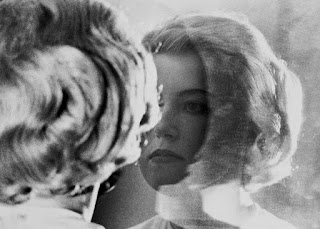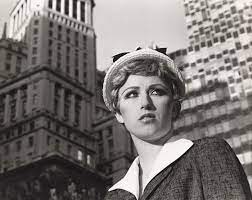 |
| Cindy Sherman Untitled Film Still #56 (1980) |
 |
| Still #1 |
 |
| Cindy Sherman Untitled Film Still #21 (1978) |
 |
| Still #2 |
Explanation of my Selfies
I decided to recreate Cindy Sherman’s Untitled Film Still #56 and Untitled Film Still #21 because I believe they are two of her photographs that spark the most curiosity regarding her thoughts and emotions when taking them. Many people seeing Untitled Film Still #56 may wonder what she was thinking of at the time, and many may immediately assume that her character is thinking of a man, and that Cindy has taken this photograph to pose for the male gaze. When seeing Untitled Film Still #21, people may wonder whether she was angry, disappointed, curious, or troubled, and whether these emotions are caused by someone else in the story that cannot be seen within the picture frame. With both photographs, I believe there are multiple interpretations, each individual to the person viewing her photograph.
The Cindy Sherman Effect
Quote #1:
“A number of younger artists are very much indebted to Sherman in their exploration of not just identity but also the nature of representation. Now we all take it for granted that a photograph can be Photoshopped. We live in the era of YouTube fame and reality-TV shows and makeovers, where you can be anything you want to be any minute of the day, and artists are responding to that” (Hoban 2012).
Response #1
Not only are photographs today simple to produce in mass quantities, but humans are also capable of manipulating its contents to suit society’s current preferences, mask one’s insecurities, or simply to spread creativity and uniqueness. Today, humans have the ability to portray any version of themselves that they choose. I believe that today’s society takes this for granted because it occurs often and has become normalized. However, I believe that something as commonly-used as photoshop, is also an incredible asset to society, because it allows people to express themselves freely through fluid, artistic transformation.
Quote #2
What has she herself discovered through her work? “I think it has made me realize that we’ve all chosen who we are in terms of how we want the world to see us,” she says (Hoban 2012).
Response #2
Cindy Sherman has realized that humans, through not only photography, but through all types of art, have the ability to choose who they want to be, and alter themselves according to the perception they wish others have of them. Today, people can decide who they want to be known as, and transform themselves into that person, perhaps not permanently, but at least through a photograph. Whether the image portrayed in the photograph is the true identity of the person in the photograph or the identity they want others to see, only the person themselves can know. The most important point, I believe, is that should people wish to portray themselves in hundreds of different ways, photography allows them to do so freely by letting people tell stories about themselves, and alter their images to cater to what they hope will be others’ perceptions of their art.
The Ugly Beauty of Cindy Sherman
Quote #1
“They are some of the first pure protagonists in Sherman’s work: These women are not metaphors, they are not waiting to be represented, rescued or destroyed” (Sehgal 2018).
Response #1
I believe that Cindy Sherman wishes to give women a representation in art that they are not often given. I believe that in photography, as in films, paintings, and most other art forms, women are displayed from a male point of view. When saying this, I believe the author of this article hopes to tell readers that Cindy’s photographs portray women who are the main character of their story, and not a supplement to another character, a helpless “maiden in distress,” or a character that serves the purpose of the male protagonist’s character development. Instead, she wishes to give women the spotlight, without having to share it with anyone else, so that each of her characters can express their stories fully, freely, and without societal, gender, or social limitations.
Quote #2
“Commenters root for the women: “I’m fixated on the thin eyebrow ... in a world of picture perfect perfection she’s given up. This is her subtle rebellion.”
These are all photographs of subtle rebellions — the first being the demand, of women of a certain age, to be noticed, admired. Or do I have it backward? The longer I look at these photographs, the less sure I am of them. Are these women insisting on being seen or are they taunting us, mischievously playing on fears of female ugliness, of becoming old and absurd or just invisible?” (Sehgal 2018).
Response #2
Many people see Cindy’s work, and wonder if she purposely goes against society’s expectations of women, or whether she simply does not care or realize that she oversteps the societal boundaries that determine how women should look in every period of their lives. I believe that through her photography, Cindy wishes to tell people that women are not mannequins that others choose to dress and set up for display the way they wish. On the contrary, I believe Cindy wishes to show that women have their own stories and their own experiences, and that regardless of age, they can portray themselves in ways that are completely against society’s set regulations, because society does not have the authority nor the right to decide whether women, like her characters, have their own stories and which can be shown to the public. Overall, I believe Cindy wishes to demonstrate that women’s identities are not contingent on others’ beliefs.
No comments:
Post a Comment